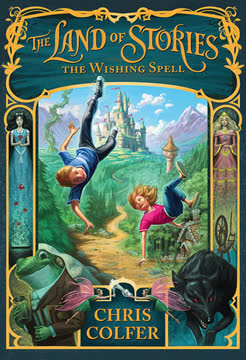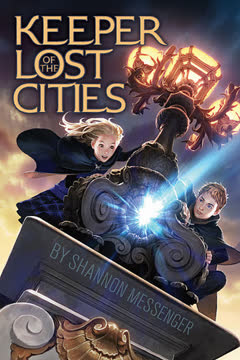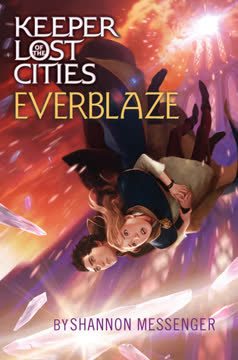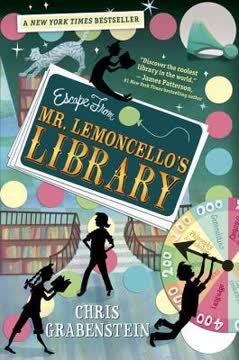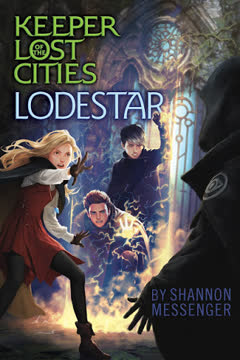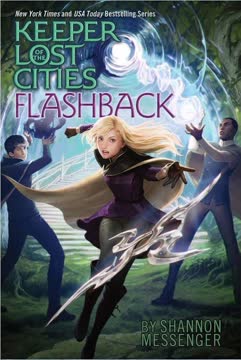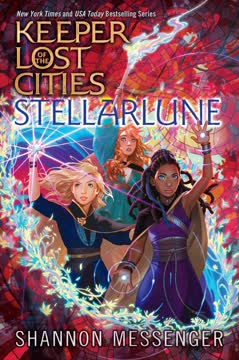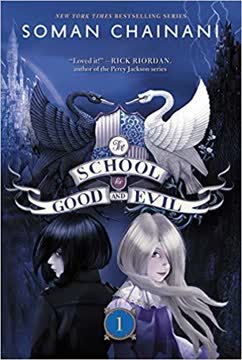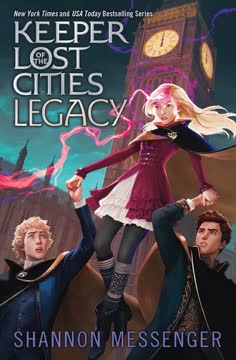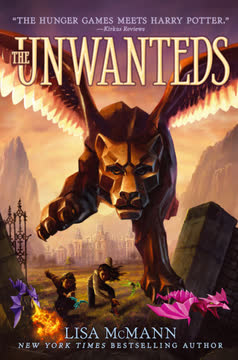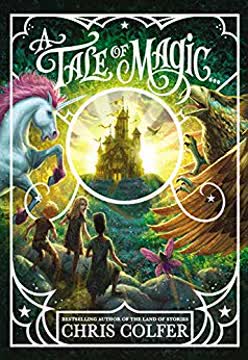Plot Summary
Broken Family, Broken World
Alex and Conner Bailey, twins in a modern world, are reeling from the recent death of their father. Their mother works long hours, and the family's financial and emotional stability is shaken. Alex, a bookish and lonely girl, and Conner, her sarcastic, underachieving brother, find solace in the fairy tales their father and grandmother once read to them. On their twelfth birthday, their grandmother gifts them a mysterious old storybook, The Land of Stories, which soon begins to glow and hum, hinting at magic and adventure beyond their mundane reality.
The Book That Glows
Alex becomes obsessed with the glowing book, convinced it holds secrets. After days of strange occurrences, she and Conner discover the book is a portal. In a moment of curiosity and chaos, both siblings are pulled into the book and find themselves in a vibrant, dangerous fairy-tale world. They quickly realize they are far from home, surrounded by living legends, and must find a way back before their absence is discovered in the real world.
Into the Fairy-Tale Forest
Lost in the Dwarf Forests, Alex and Conner are awed and terrified by the reality of fairy tales. They narrowly escape soldiers, meet a talking frog-man named Froggy, and realize that the world is divided into kingdoms ruled by familiar characters like Cinderella, Snow White, and Red Riding Hood. The twins learn that the only way home may be through the legendary Wishing Spell, a magical scavenger hunt requiring rare and dangerous items.
Froggy's Secret Sanctuary
Froggy, once a vain man cursed into amphibian form, becomes their reluctant guide. He introduces them to the Wishing Spell, sharing a journal written by a man who once used it to cross worlds for love. The twins decide to follow the journal's clues, collecting items like Cinderella's glass slipper, a lock of Rapunzel's hair, and more. Froggy's kindness and wisdom become a lifeline, but he is haunted by his own fears and regrets.
The Wishing Spell Quest
Armed with a map, the journal, and Froggy's advice, Alex and Conner set out across kingdoms. They face riddles, bridge trolls, and the perils of being outsiders. Their journey takes them to Rapunzel's tower, Cinderella's palace, and the Red Riding Hood Kingdom, where they must use wit, courage, and sometimes deception to obtain the spell's components. Along the way, they witness the complexities and flaws of their childhood heroes.
Perils in the Dwarf Forests
The twins' quest is fraught with danger: they narrowly escape a cannibalistic witch, are caught in the crossfire between Goldilocks (now a fugitive) and the Big Bad Wolf Pack, and are repeatedly reminded that fairy tales are not sanitized stories but living, perilous realities. Their bond as siblings is tested, and they begin to realize that the world's magic is as much about pain and loss as it is about hope.
Castles, Queens, and Thieves
Infiltrating Cinderella's palace, the twins are aided by sympathetic guards and even Cinderella herself, who reveals the burdens of being a queen. They accidentally acquire a glass slipper, unsure if it was theft or a gift. In the Red Riding Hood Kingdom, they face a room of thousands of baskets and a mysterious thief—later revealed to be the Huntsman's daughter—who is collecting Wishing Spell items for a darker purpose.
Red's Kingdom and Goldilocks' Past
The twins witness the tangled relationships between Jack, Goldilocks, and Red Riding Hood, learning that fairy-tale endings are rarely simple. Goldilocks, framed as a child, is now a hardened outlaw, and her love for Jack is complicated by Red's jealousy and betrayal. The twins' own quest is mirrored by the emotional journeys of those around them, deepening their understanding of love, loss, and forgiveness.
Trolls, Goblins, and Escape
Captured by trolls and goblins, Alex and Conner are thrown into a slave dungeon, where they meet the Traveling Tradesman—the very man from the journal. With the help of Trollbella, a lovesick troll princess, and their own ingenuity, the twins orchestrate a mass escape, freeing dozens of prisoners. They also acquire the stone crown, another Wishing Spell item, but at the cost of leaving the Tradesman behind.
Fairy Kingdom's Judgment
In the Fairy Kingdom, the twins must obtain a fairy's tear. They befriend Trix, a fairy on trial for a minor offense, and Conner's impassioned defense of her leads to a change in the Fairy Council's priorities. The twins learn that justice is not always fair, and that compassion can change even the most rigid systems. They also discover the Walking Fish, a living symbol of their father's stories and their own dual heritage.
The Evil Queen's Shadow
The Evil Queen, once Snow White's stepmother, has escaped prison and is collecting Wishing Spell items with the help of the Huntsman and his daughter. Her tragic backstory—her lost love, Mira, trapped in a mirror—casts her actions in a new light. The twins realize they are not the only ones seeking the Wishing Spell, and that if the Evil Queen succeeds, they may never return home.
The Sleeping Kingdom's Curse
In the Sleeping Kingdom, the twins meet Queen Sleeping Beauty, who is struggling to revive her cursed land. She lends them the spindle that pricked her finger, showing empathy and wisdom. The twins reflect on the true cost of curses and the strength required to heal a broken world. Their journey is now a race, as the Evil Queen's agents close in.
The Final Race for Home
With most items collected, the twins must retrieve the final piece: a knife from the Sea Foam Spirit (the Little Mermaid), now hidden in the cursed Thornbush Pit. With magical help, they brave the deadly vines, but nearly perish. Froggy, overcoming his fears, rescues them. Yet, as they gather the last item, the Evil Queen's wolves capture them, and the spell's fate hangs in the balance.
The Heart of Stone
Imprisoned by the Evil Queen, the twins learn her full story: once Evly, a loving woman, she was twisted by loss and heartbreak. Her heart, literally turned to stone, is all that remains of her humanity. The Evil Queen uses Alex's tear to complete the Wishing Spell, not for power, but to free her beloved Mira from the mirror. The spell works, but Mira dies in her arms, and the Queen is consumed by her own tragedy.
The Mirror's Tragic Truth
As the castle collapses, the twins are rescued by Froggy, Jack, and Red. The Evil Queen and Mira vanish into the mirror, leaving only the heart of stone behind. The Wishing Spell is spent, and the twins' hope of returning home seems lost. Yet, in the aftermath, forgiveness and understanding ripple through the kingdoms, and old wounds begin to heal.
Sacrifice and Forgiveness
Goldilocks is pardoned by Red Riding Hood, and Jack chooses a life on the run with her. Red, heartbroken, learns the value of sacrifice and leadership. Froggy is revealed to be Prince Charlie, the long-lost Charming brother, and is restored to human form by the Fairy Godmother. The twins, though stranded, are celebrated as heroes and find a new sense of belonging.
Family Secrets Revealed
The Fairy Godmother summons Alex and Conner, revealing herself as their grandmother and the true bridge between worlds. Their father, too, was from the Land of Stories, and his journal guided their quest. The twins learn they are the first children of both worlds, and that their magic enabled their journey. Their family's legacy is one of love, sacrifice, and the power to unite worlds.
Home, But Forever Changed
With the Fairy Godmother's magic, the twins return home, forever changed by their journey. They carry with them the lessons of courage, empathy, and the complexity of good and evil. The Land of Stories is no longer just a book, but a living part of who they are—and the promise of future adventures lingers in their hearts.
Characters
Alex Bailey
Alex is a bright, sensitive girl who feels out of place in her world after her father's death. Her deep love of fairy tales and longing for belonging drive her curiosity and courage. Throughout the story, Alex matures from a lonely outsider to a compassionate leader, learning that true heroism is rooted in empathy and sacrifice. Her journey is as much about self-acceptance as it is about returning home.
Conner Bailey
Conner, Alex's twin, is her opposite: quick-witted, underachieving, and often cynical. Beneath his humor lies deep insecurity and a fierce loyalty to his sister. Conner's arc is one of self-discovery; he learns to value his own strengths and to act bravely in the face of danger. His humor and honesty often diffuse tension, and his growth is marked by increasing empathy and responsibility.
Froggy (Prince Charlie Charming)
Froggy is a once-vain man transformed into a frog, living in isolation. He becomes the twins' guide, offering wisdom, hospitality, and a model of redemption. His own journey—from shame and fear to courage and acceptance—mirrors the twins' growth. Ultimately revealed as the lost Charming brother, Froggy's restoration to human form is a testament to the power of friendship and forgiveness.
The Evil Queen (Evly)
Once a loving woman named Evly, the Evil Queen is driven by loss and heartbreak after her beloved Mira is trapped in a mirror. Her transformation into a villain is rooted in pain, not malice. Her actions are monstrous, but her motivations are deeply human. The revelation of her story challenges the twins—and the reader—to see beyond labels and understand the roots of evil.
Goldilocks
Framed as a child, Goldilocks becomes a legendary fugitive, hardened by betrayal and loss. Her love for Jack and rivalry with Red Riding Hood add emotional depth to her character. Goldilocks is resourceful, fierce, and ultimately capable of forgiveness. Her arc is one of reclaiming agency and finding love on her own terms.
Jack
Jack, of beanstalk fame, is haunted by Goldilocks' absence and Red's affections. His steadfast love and willingness to abandon everything for Goldilocks reveal a depth of character beyond his fairy-tale origins. Jack's journey is about choosing love over duty and embracing imperfection.
Red Riding Hood
Red is a comically self-absorbed queen, desperate for love and validation. Her rivalry with Goldilocks and unrequited love for Jack drive much of the story's interpersonal drama. Yet, when it matters most, Red chooses forgiveness and leadership, freeing Goldilocks and beginning her own path to maturity.
The Huntsman and Huntress
The Huntsman, once the Evil Queen's servant, is consumed by guilt and loyalty. His mute daughter, the Huntress, is a formidable adversary, collecting Wishing Spell items for the Queen. Both are tragic figures, shaped by circumstance and the demands of others, embodying the theme that villainy is often inherited, not chosen.
The Fairy Godmother (Grandma)
The twins' grandmother is revealed as the Fairy Godmother, the only being able to travel between worlds. Her love, wisdom, and sacrifices underpin the entire narrative. She is the keeper of family secrets and the architect of the twins' return, embodying the story's message that love and magic are intertwined.
Snow White, Cinderella, Sleeping Beauty, Rapunzel
These iconic characters are reimagined as real women with burdens, regrets, and wisdom. Each helps the twins in different ways, revealing that fairy-tale endings are only the beginning of real struggles. Their stories challenge the twins' (and readers') assumptions about heroism, happiness, and the cost of leadership.
Plot Devices
The Wishing Spell
The Wishing Spell is a classic quest device, requiring the protagonists to collect rare items from across the kingdoms. It structures the plot as a series of escalating challenges, each tied to a different fairy tale. The spell's rules—only two uses left, and only one remaining—create urgency and competition, especially as the Evil Queen races the twins for the prize.
The Journal
The journal, written by the twins' father, is both a literal map and a metaphorical link to their heritage. It provides clues, foreshadows dangers, and ultimately reveals the truth about their family. Its presence deepens the story's emotional stakes and ties the twins' journey to their father's own quest for love.
Dual Worlds and Portals
The portal between worlds, activated by Alex's latent magic, allows for a collision of modern sensibilities with fairy-tale logic. The twins' outsider perspective exposes the cracks in the stories they thought they knew, while their heritage as children of both worlds becomes the key to their return.
Reimagined Fairy-Tale Characters
Classic characters are given new depth, flaws, and motivations. Villains are revealed as victims, heroes as fallible, and side characters as central to the plot. This device allows the story to explore themes of empathy, forgiveness, and the complexity of good and evil.
Sibling Bond
Alex and Conner's relationship is the heart of the story. Their differences create conflict, but their loyalty and love drive their survival and success. Their journey is as much about healing their family as it is about returning home.
The Heart of Stone and the Mirror
The Evil Queen's heart of stone and Mira's mirror are powerful symbols. They represent the dangers of emotional numbness and the longing for connection. Their resolution—through sacrifice and understanding—mirrors the twins' own journey toward wholeness.
Analysis
Chris Colfer's The Wishing Spell is a vibrant, emotionally resonant reimagining of classic fairy tales, blending adventure, humor, and psychological depth. At its core, the novel is about the power of stories to heal, connect, and transform. By thrusting modern children into a world of living legends, Colfer explores the gap between fantasy and reality, showing that true heroism lies in empathy, resilience, and the willingness to see beyond labels. The book's greatest strength is its refusal to simplify good and evil; villains are given tragic backstories, and heroes are shown to struggle with doubt and loss. The Wishing Spell quest is both a literal and metaphorical journey, forcing the twins—and the reader—to confront the messy, beautiful complexity of life. Ultimately, the story is a celebration of family, forgiveness, and the enduring magic of hope.
Last updated:
FAQ
Synopsis & Basic Details
What is The Wishing Spell about?
- A Modern Fairy Tale Journey: The Wishing Spell follows twelve-year-old twins, Alex and Conner Bailey, as they grapple with the recent death of their father and their mother's struggle to keep their family afloat. Their lives take an extraordinary turn when their grandmother gifts them an old storybook, The Land of Stories, which magically transports them into a world where classic fairy tales are real.
- Quest for a Way Home: Stranded in this fantastical realm, the twins discover the legendary Wishing Spell, a powerful enchantment that can grant any wish if eight specific, rare items are collected. Their adventure becomes a desperate scavenger hunt across various kingdoms, forcing them to confront familiar fairy-tale characters who are far more complex and flawed than their storybook counterparts.
- Unraveling Family Secrets: As they navigate dangers from witches, wolves, trolls, and even the infamous Evil Queen, Alex and Conner not only seek a path back to their own world but also uncover profound family secrets that link their heritage directly to the Land of Stories, forever changing their understanding of themselves and their place in the universe.
Why should I read The Wishing Spell?
- Reimagined Fairy Tale Magic: Readers should dive into The Wishing Spell for its fresh, witty, and emotionally resonant take on beloved fairy tales. Chris Colfer masterfully subverts expectations, presenting classic characters like Cinderella, Snow White, and Goldilocks with unexpected depth, flaws, and modern sensibilities, making them relatable and compelling.
- A Journey of Self-Discovery: Beyond the thrilling adventure, the book offers a powerful narrative about grief, resilience, and finding one's place in the world. Alex and Conner's individual and shared growth, as they confront their fears and embrace their unique strengths, provides a heartwarming and inspiring core to the story, making it a perfect read for those seeking character development and emotional depth.
- Engaging Mystery and World-Building: The quest for the Wishing Spell is a cleverly constructed mystery, filled with riddles and unexpected twists that keep readers hooked. Colfer's vibrant world-building brings the Land of Stories to life, inviting readers into a fantastical realm that feels both familiar and entirely new, promising an escape into pure imagination.
What is the background of The Wishing Spell?
- Grief and Financial Hardship: The story is set against the backdrop of the Bailey family's profound loss. The sudden death of their father leaves Alex and Conner's mother working tirelessly to cover mounting debts, including funeral expenses and the loss of their family bookstore. This real-world struggle for stability and normalcy deeply impacts the twins, fueling Alex's desire for escape and Conner's cynicism.
- Modernity Meets Tradition: The narrative establishes a contrast between the twins' contemporary, technology-driven world (where fairy tales are "no longer relevant") and the timeless, magical Land of Stories. Mrs. Peters's lament about "bastardized" fairy tale adaptations highlights the author's intent to return to the deeper morals and complexities of the original tales, setting the stage for the twins' immersive experience.
- A Legacy of Storytelling: The twins' connection to fairy tales is rooted in their childhood, where their father and grandmother lovingly read to them from The Land of Stories. This tradition of storytelling, passed down through generations, becomes the literal and metaphorical bridge to their adventure, revealing a hidden family history intertwined with the very fabric of the fairy-tale world.
What are the most memorable quotes in The Wishing Spell?
- "A villain is just a victim whose story hasn't been told.": This profound statement from the Evil Queen in the prologue (Chapter 0) encapsulates a central theme of The Wishing Spell analysis, challenging readers to look beyond superficial labels of good and evil. It foreshadows the complex motivations and tragic backstory that will later be revealed for many characters, including the Evil Queen herself, offering a fresh perspective on classic villains.
- "Sometimes we forget about our own advantages because we focus on what we don't have.": Mr. Bailey shares this wisdom with Conner in the "Walking Fish" story (Chapter 3), directly addressing Conner's feelings of inadequacy compared to Alex. This quote is a powerful message about self-worth and perspective, resonating with Conner's character development and highlighting the importance of recognizing one's unique talents, even when they differ from others.
- "The world will always choose convenience over reality. It's easier to hate, blame, and fear than it is to understand. No one wants the truth; they want entertainment.": Spoken by the Evil Queen (Evly) in Chapter 20, this poignant observation reflects her bitter experience with how her story was perceived. It serves as a sharp critique of societal judgment and superficiality, reinforcing the book's overarching themes in The Land of Stories about empathy and the complexity of human nature, urging readers to seek deeper understanding.
What writing style, narrative choices, and literary techniques does Chris Colfer use?
- Accessible and Engaging Narrative Voice: Chris Colfer employs a clear, straightforward, and often humorous narrative style that makes the complex world and themes accessible to young readers while still engaging adults. His third-person omniscient perspective allows for insights into both Alex's analytical mind and Conner's sarcastic observations, creating a balanced and dynamic storytelling experience.
- Subversion of Fairy Tale Tropes: A key literary technique is the deconstruction and reimagining of classic fairy tales. Colfer takes well-known characters and plots, then infuses them with modern psychological depth and realistic flaws, challenging reader expectations. For example, Cinderella struggles with public perception (Chapter 9), and Goldilocks is a hardened fugitive (Chapter 6), adding layers to their traditional portrayals and enriching the fairy tale symbolism.
- Foreshadowing and Intertextuality: Colfer skillfully uses foreshadowing, often through seemingly innocuous details or Mr. Bailey's stories (e.g., the Curvy Tree in Chapter 2, the Walking Fish in Chapter 3), to hint at deeper connections and future revelations. The constant allusions to classic fairy tales, both in their traditional and subverted forms, create a rich intertextual dialogue that rewards attentive readers and deepens the The Wishing Spell analysis.
Hidden Details & Subtle Connections
What are some minor details that add significant meaning?
- The Evil Queen's Stone Heart: In the prologue, Snow White observes her stepmother's "heart of stone" on a table, a seemingly symbolic object. This minor detail gains profound significance in Chapter 20 when the Evil Queen reveals it is her literal heart, removed by Hagatha to numb her unbearable grief for Mira. This transforms a metaphorical villain into a tragic figure, deepening the Evil Queen motivations and challenging the simplistic good-vs-evil narrative.
- Mr. Bailey's Bedtime Stories: The tales of "The Curvy Tree" (Chapter 2) and "The Walking Fish" (Chapter 3) told by the twins' father are initially presented as simple moral lessons. However, the twins later encounter these very elements—the Curvy Tree in Chapter 15 and the Walking Fish in Chapter 12—as living parts of the Land of Stories. This subtle connection reveals their father's true origins and the twins' inherent link to the magical world, foreshadowing their own magical heritage.
- Sir Lampton's Knowing Smile: When Alex and Conner attempt to sneak into Cinderella's ball (Chapter 9), Sir Lampton, the head of the Royal Guard, greets them with a knowing smirk and later helps them, even placing a glass slipper in Alex's bag. This seemingly minor act of kindness, later revealed in Chapter 24 to be because he "knew your father," highlights the hidden network of allies and the deep, unspoken connections that exist within the Land of Stories, extending beyond the immediate plot.
What are some subtle foreshadowing and callbacks?
- Mrs. Peters's Lament on Fairy Tale Adaptations: In Chapter 1, Mrs. Peters expresses frustration over "bastardized" film adaptations of fairy tales, mentioning "Cinderella as a struggling hip-hop singer and Sleeping Beauty as a warrior princess battling zombies!" This subtly foreshadows the book's own reimagining of these characters, presenting them with complex, non-traditional roles (e.g., Goldilocks as a warrior fugitive, Cinderella as a queen facing political challenges), setting up the Land of Stories themes of subverting expectations.
- Conner's "Twin-tuition": Early in Chapter 4, Conner jokingly claims to have "twin-tuition" to explain his awareness of Alex's strange behavior. This lighthearted phrase subtly hints at the deeper, almost magical connection between the twins, which is later revealed to be a manifestation of their shared fairy heritage. It foreshadows Alex's innate magical abilities and their unique role as "children of both worlds" (Chapter 24), linking their sibling bond to the story's magical elements.
- The Evil Queen's Mirror Warning: In Chapter 8, the Magic Mirror warns the Evil Queen that "a duo move throughout the land... A young brother and sister collect at a quick pace, and may defeat my queen in the Wishing Spell race." This direct, yet initially mysterious, prophecy immediately establishes Alex and Conner as the Evil Queen's rivals, creating a sense of urgency and a clear antagonist for their quest. It's a powerful piece of The Wishing Spell foreshadowing that raises the stakes significantly.
What are some unexpected character connections?
- Froggy's Royal Identity: The most significant unexpected connection is Froggy's true identity as Prince Charlie Charming, the long-lost fourth Charming brother (Chapter 24). This revelation transforms a seemingly minor, cursed character into a central figure in the royal lineage, explaining his wisdom and kindness, and adding a layer of tragic backstory to the Charming family. It highlights the theme of hidden potential and the importance of looking beyond appearances.
- Jack and Goldilocks' Secret Romance: The enduring, forbidden love between Jack (of beanstalk fame) and Goldilocks (the fugitive) is a surprising twist on their traditional narratives (Chapter 10). Their clandestine meetings and Jack's unwavering loyalty to Goldilocks, despite Red Riding Hood's affections, reveal a deep emotional complexity. This connection subverts expectations, showing that even in fairy tales, love can be messy and defy societal norms, adding a romantic subplot to the Goldilocks character analysis.
- Snow White's Compassion for the Evil Queen: In a shocking twist (Chapter 22), Snow White reveals that she helped her stepmother, the Evil Queen, escape prison. This unexpected act of empathy, driven by Snow White's understanding of her stepmother's tragic past, completely redefines their relationship. It challenges the traditional hero-villain dynamic, emphasizing themes of forgiveness and the profound impact of understanding another's pain, offering a fresh perspective on Snow White's character development.
Who are the most significant supporting characters?
- Sir Lampton, the Observant Royal Guard: Sir Lampton, initially appearing as a minor palace guard, proves to be a crucial, albeit subtle, ally. His quiet observation of the twins, his gentle amusement at their antics, and his deliberate act of placing a glass slipper in Alex's bag (Chapter 24) demonstrate his deep connection to their father and his understanding of their quest. He represents the hidden kindness and wisdom that exists even within the rigid structures of the fairy-tale world, providing unexpected aid in The Wishing Spell quest.
- The Traveling Tradesman, a Link to the Past: The Traveling Tradesman, first mentioned in the journal as the source of information about the Wishing Spell (Chapter 7), later appears as an enslaved prisoner in the Troll and Goblin Territory (Chapter 11). His capture and eventual sacrifice to help the twins escape highlight the dangers of the world and the cost of knowledge. He serves as a poignant reminder of the journal's author's journey and the real-world consequences of seeking magic, deepening the Land of Stories themes of sacrifice.
- Trollbella, the Unexpected Ally: Trollbella, the troll princess, initially appears as a comical, lovesick antagonist (Chapter 11). However, her infatuation with Conner becomes the unexpected catalyst for the twins' escape from enslavement. Her character demonstrates that even those from "evil" races can possess unexpected kindness and a desire for connection, subverting the typical portrayal of trolls and goblins and adding a touch of humor and humanity to a dire situation.
Psychological, Emotional, & Relational Analysis
What are some unspoken motivations of the characters?
- Alex's Deep-Seated Loneliness and Desire for Belonging: While Alex explicitly states her desire to meet her "friends" in the fairy-tale world (Chapter 6), her unspoken motivation is a profound loneliness exacerbated by her father's death and her feeling of being an outcast at school. Her eagerness to embrace the magical world and its inhabitants stems from a deep yearning for a place where she truly belongs and is understood, driving her Alex Bailey character development and quest.
- Conner's Mask of Sarcasm and Insecurity: Conner's constant sarcasm and underachieving facade (Chapter 1) are unspoken coping mechanisms for his grief and his insecurity about not being as "smart" as Alex. His initial reluctance to engage with the fairy-tale world and his desire to return home quickly are rooted in a fear of further loss and a need for the familiar, even if imperfect, comfort of his own world, revealing the layers beneath his Conner Bailey motivations.
- The Evil Queen's Quest for Redemption and Lost Love: The Evil Queen's relentless pursuit of the Wishing Spell is not for power or vanity, but an unspoken, desperate attempt to free her beloved Mira from the Magic Mirror (Chapter 20). Her entire life's villainy, including her crimes against Snow White, is revealed to be a tragic consequence of her profound heartbreak and a desperate, misguided effort to reclaim her lost love, offering a complex Evil Queen analysis that evokes empathy.
What psychological complexities do the characters exhibit?
- Snow White's Burden of Forgiveness and Empathy: Snow White, despite being the victim of her stepmother's cruelty, exhibits immense psychological complexity by choosing to understand and even aid the Evil Queen (Chapter 22). Her internal struggle to reconcile the "Evil Queen" with the heartbroken "Evly" demonstrates a profound capacity for empathy and forgiveness, challenging the simplistic hero archetype and highlighting the emotional toll of her past.
- Red Riding Hood's Vanity as a Shield for Insecurity: Queen Red Riding Hood's exaggerated vanity, self-obsession, and constant need for attention (Chapter 10) are psychologically complex defenses against deep-seated insecurity and a desperate longing for love, particularly from Jack. Her past betrayal of Goldilocks, driven by jealousy, reveals the destructive nature of her unaddressed emotional needs, making her a more nuanced character than a simple "prissy queen."
- Sleeping Beauty's Post-Traumatic Responsibility: Queen Sleeping Beauty, having awoken from a century-long curse, carries the psychological burden of her kingdom's stagnation (Chapter 14). Her sleeplessness and unwavering determination to restore her land, even at personal cost, show a complex sense of responsibility and guilt. She embodies the psychological aftermath of a traumatic event, demonstrating that "happily ever after" is often just the beginning of new, profound challenges.
What are the major emotional turning points?
- The Twins' Discovery of Their Father's Origins: The emotional turning point for Alex and Conner occurs in the Dwarf Mines (Chapter 16) when they realize their father was from the Land of Stories, triggered by seeing the Curvy Tree. This revelation transforms their quest from a simple journey home into a deeply personal exploration of their heritage, filling the "emptiness they were left with when their dad died" and providing a new sense of purpose and connection to their lost parent.
- The Evil Queen's Tragic Reunion with Mira: The most poignant emotional turning point is the Evil Queen's use of the Wishing Spell to free Mira, only for him to die in her arms (Chapter 21). This moment of profound grief humanizes the villain, revealing the depth of her love and the ultimate futility of her life's work. It forces the twins, and the reader, to confront the tragic consequences of her choices and the devastating power of loss, serving as a powerful The Wishing Spell analysis of sacrifice.
- Froggy's Embrace of His True Self: Froggy's decision to leave his secluded home and actively help the twins (Chapter 19), culminating in his transformation back into Prince Charlie Charming (Chapter 24), marks a significant emotional turning point. Overcoming years of shame and fear of judgment, his actions demonstrate the power of courage and self-acceptance, leading to his long-awaited reunion with his brothers and a renewed sense of purpose.
How do relationship dynamics evolve?
- Alex and Conner: From Bickering to Unbreakable Bond: The sibling bond between Alex and Conner evolves significantly, moving from typical sibling rivalry and Alex's frustration with Conner's antics to a deep, mutual reliance and understanding. Their shared dangers and triumphs forge an unbreakable bond, as seen when Conner saves Alex from drowning (Chapter 16) and Alex defends Conner's ideas to the Fairy Council (Chapter 12). This transformation is central to their sibling bond analysis.
- The Twins and Fairy Tale Characters: From Awe to Empathy: Initially, Alex and Conner view the fairy tale characters with childlike awe, but their interactions quickly reveal the complex, flawed humanity beneath the legendary personas. Their relationships evolve from hero-worship to genuine empathy and understanding, as they witness Cinderella's burdens (Chapter 9), Goldilocks's pain (Chapter 10), and the Evil Queen's tragedy (Chapter 20), fostering a more mature perspective on heroism.
- Goldilocks and Jack: A Love Forged in Adversity: The relationship between Goldilocks and Jack deepens from a secret, star-crossed romance to an open commitment to a life together on the run (Chapter 22). Their shared history of betrayal and longing culminates in Jack's choice to abandon his royal prospects for a life with Goldilocks, demonstrating a powerful bond built on unwavering love and mutual sacrifice, challenging the traditional "happily ever after" narrative.
Interpretation & Debate
Which parts of the story remain ambiguous or open-ended?
- The Full Extent of the Twins' Magic: While it's revealed that Alex and Conner are "children of both worlds" and possess innate magic (Chapter 24), the precise nature and limits of their abilities remain largely unexplored. Alex's ability to activate the Wishing Spell with her tear and her reflection showing wings are hints, but the full scope of their powers and how they might develop in the future is left open-ended, inviting speculation about their destiny in The Land of Stories.
- The Future of the Land of Stories' Governance: Conner's blunt critique of the Fairy Council's focus on minor issues while major threats like troll enslavement persist (Chapter 12) raises questions about the effectiveness and future direction of the Happily Ever After Assembly. While the council takes action, whether this leads to lasting systemic change or if the kingdoms will continue to face similar, unaddressed dangers is left ambiguous, prompting readers to consider the ongoing challenges of leadership and justice.
- The Fate of the Evil Queen and Mira: After the castle collapses, the Evil Queen and Mira vanish into the shattered Magic Mirror (Chapter 21), with Alex finding only the heart of stone. Their ultimate fate—whether they are truly gone, trapped in another dimension, or transformed—is left open to interpretation. This ambiguity allows for a lingering sense of tragedy and the possibility of their return or a different kind of existence, adding a layer of mystery to the Evil Queen ending explained.
What are some debatable, controversial scenes or moments in The Wishing Spell?
- Red Riding Hood's Betrayal of Goldilocks: The revelation that Red Riding Hood, a seemingly innocent fairy tale character, deliberately framed Goldilocks as a child out of jealousy for Jack (Chapter 17) is a controversial moment. This act of malice challenges the traditional perception of Red as a pure victim, forcing readers to confront the darker side of even beloved characters and sparking debate about the nature of "villainy"
Review Summary
The Wishing Spell received mixed reviews from readers. Many praised its imaginative fairy tale world, entertaining characters, and nostalgic appeal. Some found it charming and fun, especially for younger readers. However, critics noted simplistic writing, predictable plot elements, and underdeveloped characters. Some felt it lacked depth for older readers. While some loved the twist on classic fairy tales, others found the morality heavy-handed. Overall, it seems to be an enjoyable, if flawed, middle-grade fantasy adventure.
The Land of Stories Series
Similar Books
Download PDF
Download EPUB
.epub digital book format is ideal for reading ebooks on phones, tablets, and e-readers.
